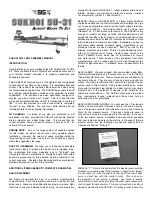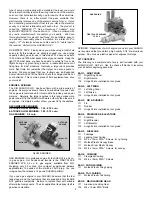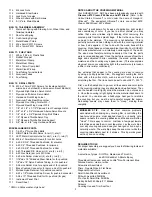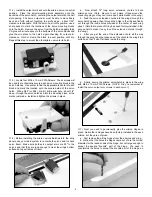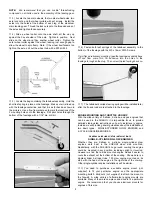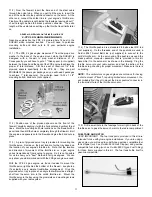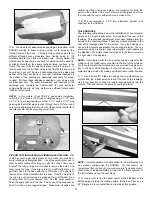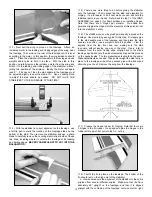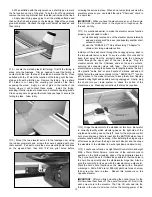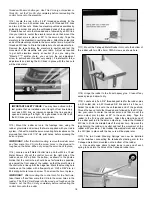
3
❑
4
M4 Lock Nuts
❑
2
Hardened Steel Axles
❑
2
Lock Nuts, for axles
❑
4
Wheel Collars with Set Screws
❑
2
3-1/2" dia. Main Wheels
BAG 10: TAILWHEEL ASSEMBLY
❑
1
Main Leaf-Spring with Steering Arm, Wheel Yoke, and
Tailwheel installed
❑
1
Short Leaf-Spring
❑
2
Coil Steering Springs
❑
1
Metal Rudder T-Horn
❑
2
M2 x 9mm PWA* Screws
❑
3
M3 x 14mm PWA* Screws
BAG 11: FUEL TANK
❑
1
450cc (15.2 oz.) Plastic Tank
❑
1
Rubber Stopper
❑
1
Metal Front Clamp
❑
1
Metal Rear Clamp
❑
1
M3 x 18mm Clamp Bolt
❑
1
Metal Clunk Pickup
❑
1
Fuel Tubing for inside tank
❑
3
Aluminum Tubes
❑
2
Fuel Tubing
BAG 12: SMALL PARTS
❑
16 M2.6 x 10mm PWA* Screws, for fuselage hatch(4),
aileron servo hatches(8), aileron servo mount blocks(4)
❑
1
Plywood Right Aileron Servo Hatch
❑
1
Plywood Left Aileron Servo Hatch
❑
1
Hardwood Front Wing Joiner
❑
1
Aluminum Tube Rear Wing Joiner
❑
1
Plywood Front Wing Former WF-1
❑
1
Plywood Rear Wing Former WF-2
❑
1
1/8" x 3-1/2" x 7-1/2" Plywood Front Fuselage Hatch
❑
4
3/8" x 3/4" x 3/4" Hardwood Aileron Servo Mounts
❑
2
1/8" x 3/4" x 3/4" Plywood Wing Bolt Plates
❑
1
1/8" Plywood Throttle Servo Tray
❑
1
1/8" Plywood Throttle Pushrod Support
❑
2
3/8" dia. x 1-5/8" long Hardwood Dowels
MISCELLANEOUS PARTS
❑
2
1/4-20 x 2" Nylon Wing Bolts
❑
2
RIGHT Metal Control Horns; for ail.(1), ele.(1)
❑
3
LEFT Metal Control Horns; for ail.(1), ele.(1), rud.(1)
❑
24 M2.6 x 10mm Metal Screws; for control horns
❑
2
4-40 X 2-3/4" Threaded Pushrods; for elevator
❑
2
4-40 X 4" Threaded Pushrods; for ailerons
❑
1
4-40 X 4-5/8" Threaded Pushrod; for rudder
❑
5
4-40 Threaded R/C Links; ail.(2), ele.(2), rud.(1)
❑
5
4-40 Hex Nuts; jam nuts R/C Links
❑
5
4-40 size Solder Links; ail.(2), ele.(2), rud.(1)
❑
1
1/16"od x 18" Stranded Steel Cable; for thr. pushrod
❑
1
1/8"od x 18" Nylon Pushrod Tubing, for thr. pushrod
❑
1
2-56 size Solder Link; for engine end of thr. pushrod
❑
1
Brass Pushrod Connector; for servo end of thr. pushrod
❑
1
Molded Nylon Retainer; for pushrod connector
❑
1
4-40 x 1/8" Socket-Hd Cap Screw; for pushrod connector
❑
1
2-56 x 10" Threaded Rod; for thr. pushrod (for gas)
❑
1
Instrument Panel Print
❑
1
Decal Sheet
* PWA = phillips washer-style head
NOTES ABOUT THE COVERING MATERIAL
Your SUKHOI SU-31 ARF has been professionally covered with
Oracover
®
#12 Cream, #40 Green, and #71 Black. (Note: In the
United States, Oracover
®
is sold under the name of Hangar 9
Ultracoat
®
.
The equivalent Ultracoat
®
colors are called #878
Cream, #880 Green, #874 Black).
Oracover
®
is well known for its ease of application, light weight,
and consistency of color. If you live in a drier climate, you may
notice that some wrinkles might develop after removing the
covered parts from their plastic bags. If that is the case, there is
no need to be alarmed. The covering is not defective. This is
perfectly normal and has nothing to do with the covering material
or how it was applied. It has to do with the wood beneath the
covering. Wood takes on or loses ambient humidity. Your SUKHOI
ARF was manufactured in a relatively humid region of the world.
The wood was therefore holding humidity at the time the parts
were covered and bagged. Once the parts are removed from their
bags and subjected to drier conditions, the wood quickly loses
moisture and the covering may appear loose. (This also explains
why most iron-on coverings stay tight in the summer only to loosen
a little in drier winter conditions.)
Any wrinkles that appear in the covering are easy to remove
by using a hobby-type heat iron. We suggest covering the iron's
shoe with a thin cotton cloth, such as an old T-shirt, to prevent
scratching the film. The iron should be set to about 280
O
- 300
O
F.
First, use the heated iron to go over all the seams and color joints
in the covering, making they are all sealed and well adhered. Then
use the heated iron to lightly shrink the material - do not press on
it. Once the covering is tight, lightly iron the material back down to
the wood. You can also use a hobby-type heat gun to re-shrink
the covering, but you must be extra careful around the seams.
Re-heating seams may cause them to "creep", making them
unsightly.
REQUIRED TOOLS
For proper assembly, we suggest you have the following tools and
materials available:
A selection of glues - SIG Thin, Medium and Thick CA,
and SIG Kwik-Set 5-Minute Epoxy
Threadlock Compound, such as Loctite
®
Non-Permanent Blue
Silicone Sealer - clear or white
Screwdriver Assortment
Pliers - Needle Nose & Flat Nose
Diagonal Wire Cutters
Small Allen Wrench Assortment
Drill with Assorted Drill Bits
Pin Vise for Small Dia. Drill Bits
Hobby Knife With Sharp #11 Blades
Scissors
Covering Iron and Trim Seal Tool
MODELER’S TIP:
One of the most common problems
associated with shrinking any covering film is controlling the
heat around seams. Heat applied close to or directly onto
seams re-heats the covering adhesive and the seam will often
"crawl". This is easy to control. Just tear a few paper towels
into strips and soak them in cool tap water. Lay the wet strips
over any covering seam and use your heat gun or iron as you
normally would. The wet strips keep the seam cool while the
covering immediately next to it shrinks. This tip works great
with any iron-on covering.
Summary of Contents for SUKHOI SU-31 ARF
Page 23: ...23 ...

